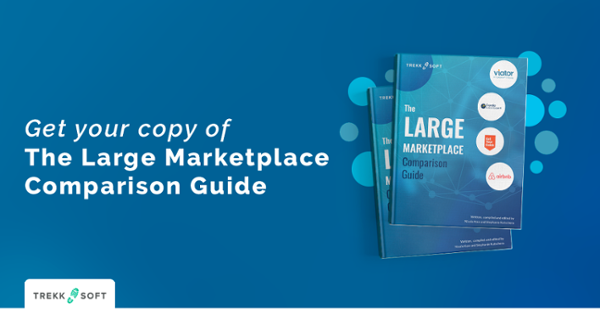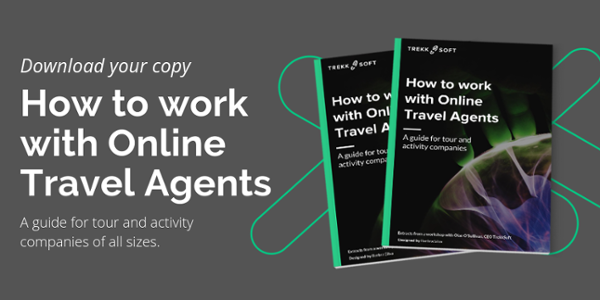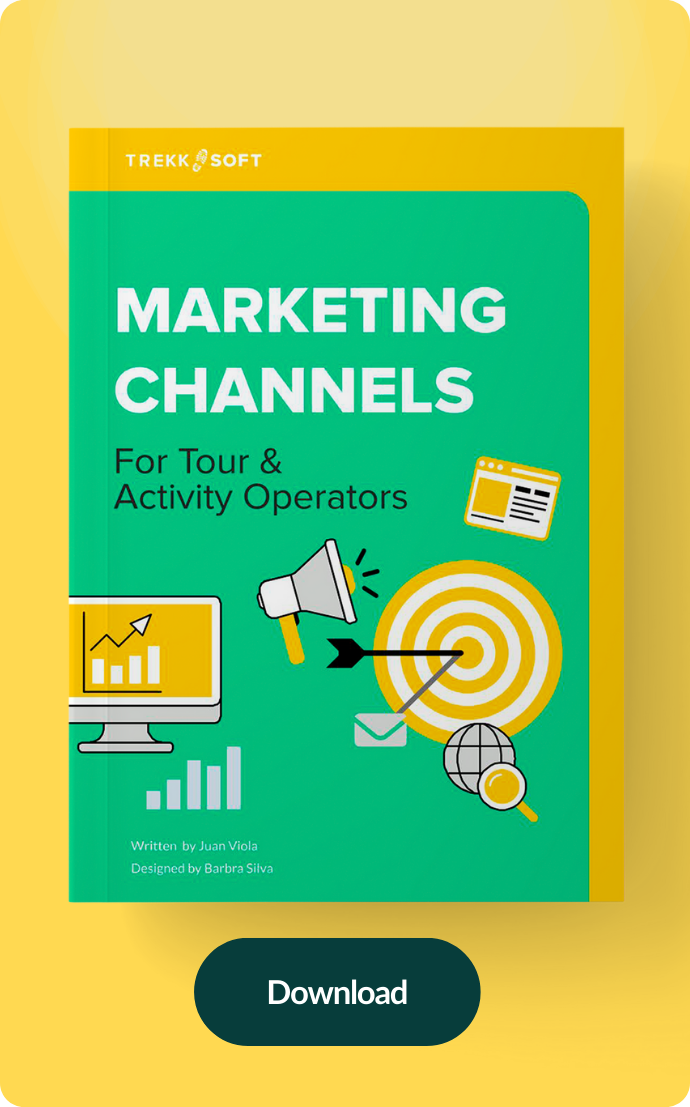This post was originally published in 2018 and has been updated in July 2021 for relevance.
With so many ways to promote your tours, it's worth putting some thought into your distribution channels. How are you getting your tours in front of your customers? What range of channels are you using online and offline, what free advertising options are there?
Online Travel Agents (OTAs) such as Viator and Expedia are key distribution channels, but should only be one part of a balanced distribution plan to ensure your tour and activity business's recovery and sustainable future.
To help you decide which distribution channels are best for your company, here is rundown of what we consider to be the best channels for tours and activities:
1. Your website
In 2019, Arival found that operators conducted a whopping $44 billion in sales via their own websites.
Research, planning and booking tours and activities are no longer what they used to be. Travellers are used to purchasing and booking other products and services online, so why can't they book a tour or activity online too?
The pandemic has also accelerated the rate of digital adoption due to tighter health and safety regulations. Tours to famous attractions now require timed ticketing to adhere to social distancing and capacity limitation guidelines. For travellers, it also makes sense to book and secure a spot in advance so that their much anticipated city break is relished.
2. Google My Business
Getting your tour company listed on Google is crucial. It's simple to do (click here to get started) and allows you to add your business, opening hours, phone number, and directions. Your listing will come up on Google Search which adds trust to your customers when booking. It will also appear on Google Maps which will help with customer directions.
3. TripAdvisor
TripAdvisor should be one of your top priorities as a tour operator. Phocuswright’s study prepared for TripAdvisor revealed that 53% of bookers would not commit to booking until they read reviews, and 80% would read between 6 -12 reviews before booking.
Here's how to get closer to the #1 spot on TripAdvisor for your destination.
4. Social media
Social media is an effective (and free) way to reach new customers, so it's definitely worth considering as one of your basic distribution channels. But rather than trying to succeed on every social media channel out there, it's worth working out which platform reaches your selected audience.
Where does word of mouth travel best for your company? If it's on Facebook, you could dedicate more time to it. Are your tours very visually marketable? If so, Instagram may well be worth the time investment. Your social media strategy should always be adjustable.
5. Media attention
Do you offer something unique, or do you have an interesting take on the local tourism space that you'd like to share? The media is a great distribution channel if you have fresh and relevant content.
Create an experience that's different and contact local journalists for their opinion. If they are interested in hearing more, then you can share the story even further.
Read more: How to organise a FAM trip and get the media coverage you deserve
6. Online Travel Agents (OTAs)
As we noted in our 2020/21 Travel Trends Report, OTA bookings were the fastest growing booking channel in 2019 (pre-pandemic) and made up just over a third of all our bookings. We expect OTAs to play a crucial role in recovery as more and more travellers go online to research, plan and book their next (safe) escape.
There are many types of OTAs to work with, not just the popular ones like Viator, GetYourGuide, Trip.com, Groupon, or Expedia. It is important to note, however, that larger OTAs tend to be very selective with who they work with and as we've seen with Viator, they're focusing more on high quality tours rather than simply adding more tours to the site.
Larger OTAs are also more focused on profitability which means that operators receive less attention and support from these OTAs when it comes to setting up their product listings. With this in mind, it is important that you work with a reputable booking system provider who can offer seamless API connections to larger OTAs.
Lastly, there is also concern over the role and dominance of OTAs once travel resumes. GetYourGuide has invested heavily into its own branded tours, Originals, launched back in 2018, and acquired Versailles operator Guidatours in April 2021. Potential conflicts of interest between promoting their own products over those of the operators its supposed to represent have been discussed by news sites and dismissed by the OTA.
Other, smaller, OTAs you could look into include Headout, Globol, Aoliday, Lulu Trip and many many more.
Not sure who to work with? Compare Viator, Expedia, GetYourGuide and Airbnb Experiences (and more) in one place.
7. Destination-specific OTAs
We've recently announced our partnerships with Swiss Activities and Tourism Exchange Great Britain (TXGB), two platforms that work exclusively with tour and activity operators in their specified destinations.
The great thing about working with country or destination OTAs is that they're experts in selling your destination, and understand how best to position your products in front of local and international customers who are interested in visiting your destination.
8. Vertical-specific OTAs
These are marketplaces that focus on a specific vertical, for example watersports or adventure tours.
Civitatis, for example, is the largest marketplace for Spanish tours while TourRadar focuses exclusively on multi-day tours. Manawa by Adrenaline Hunter resells on thrilling outdoor experiences while Silverscreen Tours offers tours to popular film locations, tv-show or movie themed tours.
9. Direct offline bookings
Direct offline bookings are still highly in demand, especially as most tour and activities are booked once the traveler is in-destination as they are often weather-dependent, or there is a lot to choose from.
Advertising and stalls in destination 'hot spots' are key to selling additional tours.
10. Sell through other tour operators and activity providers
Building a partnership and cross-selling your activities via TrekkSoft's Partner Network with other tour and activity companies could be a lucrative step for those on both sides of the deal.
Can you recommend each other when full or if your customer requests something you don't offer? You could even bundle your complementary activities as a package, perhaps at a discounted price for guests.
11. Visitor information centres
If you have a local visitor information centre, this can be a really valuable partner. A lot of VICs are willing to act as an agent and sell your tours directly, and can do so easily with TrekkSoft's Point of Sale (POS) desk. They can take an agreed commission when they book tour and activities.
Also check if you can put up marketing materials such as leaflets, brochures, or discount codes for your tours at their centres.
Read more: The power of well designed (and well placed) brochures
12. Your destination's website
Is there a government-funded destination website you can promote your tours? This may just involve being on a list of suppliers but, increasingly, destination management organizations (DMOs) are acting as a marketplace and selling local tours and activities on their own website.
Some long-term DMO partnerships we've built include Fjord Norway, Interlaken Tourism, Davos Klosters, and Engadin St. Moritz.
If your local DMO is considering this move, it's worth being a part of it.
13. Inbound tour operators
If you have an established product with a good reputation in-destination, you should be in a good position to work with inbound tour operators (ITOs). They're looking for the best of your destination, and your business will stand above the rest if you're offering a unique tour with great reviews and value for money.
Read more: How much commission should you pay for distribution?
14. Sales agents
Do you have contacts in the tourism industry who would be willing to sell your tours for you? With the TrekkSoft Booking Desk, you can allow agents (depending on their user rights) to view upcoming trips and availability, book trips, sell vouchers/add-ons, and even generate widgets to use on their own websites. And you can view all of your bookings in real-time on one handy dashboard.
15. Hotel concierges
Guests want recommendations of the best local tour and activities, tour operators want the visibility, and hotels can benefit from the commission. It makes good business sense for both hotel and supplier. With TrekkSoft, concierges can book directly into your system and see availability in real-time – without risk of overbooking.
16. Hostels
Often, but not always, visitors who stay in hostels can be more adventurous and open to activities with new people than those staying in hotels. Tour and activity operators can benefit from cultivating a special relationship with their local hostel.
This could involve a dedicated booking desk in reception, the option to book tours with the accommodation booking, marketing materials inside and outside the hostel (such as a board listing the next departure), or a dedicated departure time each morning from the hostel.
17. Airbnb Hosts
Partnering with local Airbnb hosts can be a great way to get precious word-of-mouth referrals for your tours. To find out who you should work with, go on Airbnb and look for local listings in your destination. Find out what travellers say about them to gauge if they'd be a good partner to work with.
From there, send them a message, take them on a tour and offer them a referral commission for each new booking.
Read more: How to work with Airbnb hosts to promote your tours and activities
18. Restaurants
Are you on good terms with local restaurants? Are any promoting or reselling your tours, or partnering with you? Depending on your activity, it might make sense to package it with a meal provided by a local restaurant. For instance, you could combine a ski trip with a stop for fondue at a restaurant in the mountains. With TrekkSoft, it's easy to offer packages to your customers. The software also handles all payouts, invoicing and commission for you.

Photo by MING Labs on Unsplash
How do you pick the right channels for your business?
It all goes back to your ideal customer. Who does your business serve and where are they likely to book a tour? If you offer budget outdoor experiences, it would make sense to work with smaller OTAs like Adrenaline Hunter, midrange Airbnb hosts, hotels, and hostels.
While your website is a great place to sell your tours, other channels can help you reach people you might find hard to reach on your own. When choosing the right mix of channels, consider the following:
- Can this marketplace reach my ideal customer more efficiently than I can? Are they more cost-efficient?
- Can this marketplace or reseller help me expand into a new market more efficiently? They might have market insights that you do not possess.
- Does this reseller offer additional services? Perhaps they offer translation services or free photo services that you can also use for your own website.
- How does working with this reseller impact my bottom-line? Can I afford the commissions?
Don't forget to consider the non-negotiables for every operator: your website, your social media, and your TripAdvisor listing.
How can you stay on top of so many channels?
Answer: With a channel manager.
What is a channel manager? A channel manager allows businesses to manage multiple distribution channels (OTAs or other online marketplaces) from a single interface.
What are the benefits? Coupled with a live booking system, a channel manager can update your availability in real time whenever a booking is made. This reduces admin, prevents human error, and removes the risk of overbooking.
With a channel manager, each spot on your tours or activities is also promoted on your chosen range of OTAs simultaneously. This multiplies the opportunity to get booked by a customer.
A majority of business spend no more than an hour managing their bookings via OTAs each week, but a significant amount spend more than two hours per week. A channel manager is the best way to cut down on this admin.
Connect your live inventory to distribution channels like Viator, Expedia, GetYourGuide plus your agents and resellers with TrekkSoft.
Header image by Dstudio Bcn on Unsplash





